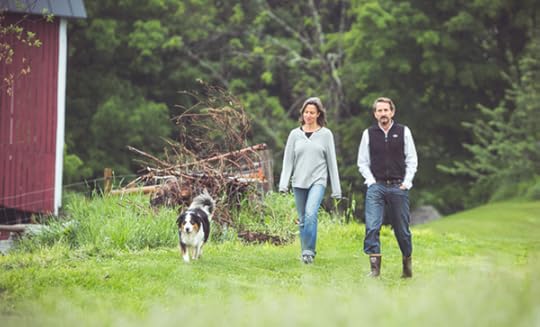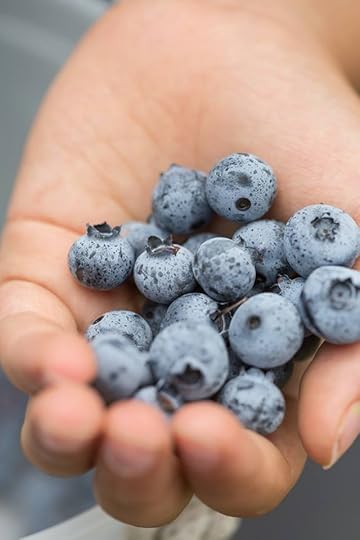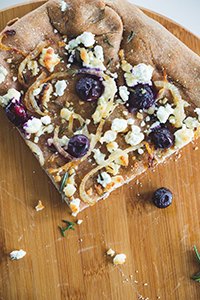Knoll Farm and the Center for Whole Communities A Family Farm with Wide Horizons

Photo by Brent Harrewy
Helen Whybrow and her husband, Peter Forbes, are the proud owners of Knoll Farm, an organic family-owned business. They grow highbush berries and raise purebred Icelandic sheep for breeding stock, wool and grass-fed meat.
Knoll Farm is also known as the birthplace of the Center for Whole Communities, a nonprofit organization that the couple founded in 2003 and which is now run by Executive Director Ginny McGinn. The Center for Whole Communities offers leadership development retreats that focus on bringing together the environmental and social justice movements. Through their programs and ongoing support, they network with more than 1,500 leaders in 450 organizations and communities throughout 47 states and Canada.
The work of the Center for Whole Communities is to knit together the environmental and social justice movements, nurture leadership and communities, and lend support to other similar-minded organizations from around the country. The mission of the organization is to bring these conversations, revenue streams and ideas together so that there is a more holistic approach to social and environmental change. It is a curriculum that has evolved over a number of years with the help of a great many people from across the country.
“Traditionally, the mainstream environmental movement has been separate from that of social justice. On the one hand, people from the environmental sector are working on issues such as clean water and protecting farmland, while a social justice group might be focused on matters of public health, or the issue of improving food access and food security,” says Helen.
Helen gives an overview of the synergy that has existed between Knoll Farm and the Center for Whole Communities for over a decade:
“We were fortunate enough to find this property through the Vermont Land Trust, but part of our deal in purchasing the land was to offer educational opportunities for the conservation movement as well as to keep it going as a family farm. With Peter’s deep background in land conservation, we began by creating a refuge for conservationists and others working on land issues to come together and think creatively. Soon this evolved into convening those who work primarily on land issues and those working mainly on social issues, and with the help of many talented people from around the country, we built a curriculum that focuses on ways that issues affecting land and issues affecting people could be seen as one lens for improving community health. To have these conversations on a piece of land that is itself attempting to model ecosystem health was an important component of what we were after. The landscape and foodscape of the farm was always a powerful teacher as well as a gracious host for our participants.”
“Peter worked in the conservation movement for a long time. He was the New England director for the Trust for Public Land. Over and over again, he would see that saving, or conserving, a piece of land without the full engagement of the community was basically like putting a Band-Aid on the larger problem of land loss in this country. The whole social engagement aspect of land and nature is central to Peter’s vision for the success of conservation in our country,” explains Helen.
When many people who work in the environmental movement get together to talk about solutions to the larger problem, they often meet in hotels that do not have any windows, or in a conference room with a corporate feel. They are not really connected to the land, or the work that they are doing.
Helen and Peter had the vision of creating a refuge of sorts for environmental activists which would be land based, located on a farm. Participants would be offered food that was grown in the garden, served shortly after it was picked. Knowing that the leaders who came to the farm were working on hard issues, the couple hoped that a setting that felt personally renewing could help people drop into a deeper conversation and set of solutions than they would otherwise find. “This is the ‘why’ of how we began,” explains Helen.
“As we started working with conservationists, we realized that it was very difficult to have a conversation about land in this country, or its protection and access, without addressing the very real issues of power and privilege, race and class. Therefore, our work started to migrate more toward social justice, inclusion, racism and diversity as it plays out around land and leadership, history and identity. We then started to invite people from around the country to our farm who had a great deal of expertise and awareness of these matters to deepen and expand the work beyond where we could go,” says Helen.
The couple’s goal then became about creating a place where hard conversations could happen that were centered on land and its access and equity.
“The work has been very much about raising issues, and generating conversations that get to the core of the social and environmental problems in this country, issues that don’t often get addressed.”
Of particular interest to many visitors to the farm is the flock of horned Icelandic sheep. Helen and Peter started with a small group of the breed approximately 12 years ago, which has now grown to around 70 animals. Icelandic sheep are one of the more ancient breeds and have been bred and farmed in Iceland for almost 1,500 years. They are an ancient, or heritage breed, with unique characteristics. Helen also uses them as a tool for pasture renovation.
“The lambs are born in April and stay with their mothers throughout the summer, going to market at about eight months of age. They are fed only grass and their mother’s milk; we don’t wean them. Our sheep are moved every two to three days, eventually grazing all of the pastures. The areas that they graze are rested long enough to build root mass and soil fertility which has been stimulated by the grazing, and fertilized by the animals. These rugged creatures have many qualities that one would associate with wild sheep. They only come into heat in the fall and both sexes have horns. Icelandic sheep deliver their lambs most often on their own without a lot of problems, or need for assistance, and are very hardy.
“Our barn wasn’t set up for sheep so we wanted to be able to lamb outdoors and not have a breed that was so highly bred that it needed a great amount of help during lambing. Our animals certainly meet these requirements. The females are protective of their young and are extremely good mothers. Another positive is that these self-sufficient animals need very little supplemental feed to thrive and that works with our goals of making the farm a largely closed-loop system without a lot of inputs in the way of grains, fertilizers and so on.”
Knoll Farm raises its Icelandic sheep primarily for breeding stock, and their breeding rams have gone to sheep farms as far away as Alaska and Georgia. Their grass-fed lamb, plentiful in the fall and winter, is sought after by restaurants and is available to customers at the farm, at holiday farmers’ markets, and also through the Intervale Food Hub in Burlington.
Knoll Farm also grows certified organic blueberries. There are two types of blueberries that are native to the Northeast: the lowbush, which is very close to the ground and harvested with a rake, and the highbush variety. Knoll Farm is well suited to highbush blueberries, which grow four to six feet high and do very well in the local soil. The highbush likes an acidic soil, typical of upland slopes in the Northeast. That soil and the perfect location for growing the fruit, a piece of land that tilts to the southeast with lots of sunshine, make Knoll Farm a winning combination.
Some of their highbush are the older heirloom variety and have a distinctive taste. Helen and Peter grow about an acre of blueberries and have also put in small quantities of peach, plum, kiwi, sour cherries, apples and currants.
“Eventually, we hope to sell more fruit, but right now we are only marketing blueberries,” says Helen. The farm has a popular pick-your-own berry orchard, open daily in July and August, and sells frozen berries and jams year-round at farmers’ markets and at the farm.
“Life at Knoll Farm is an exciting combination of so many of the things that I am passionate about, such as caring for plants, animals and soils, and feeling a part of this small ecosystem. I love having a place where people from all over feel welcome, one that also provides food for our community. Being outdoors and working with my hands brings me joy. I also like that farming can be an intellectual pursuit; it requires daily problem solving and mental agility. The grunt labor keeps you humble and requires you to dig down for your patience and perseverance—even if I don’t always love it at the time!”
Helen served on the board of NOFA-VT for six years and recently co-produced the film Organic Matters about organic farming in Vermont. She is also featured in another film about the history of hill farming in the Mad River Valley.
“It is truly exciting to see what is happening in Vermont in terms of the revitalization of farming and the food system, and so inspiring to connect with all the great people who are moving it forward and coming up with innovative solutions. It keeps me going to feel like I’m part of a larger movement and to be around people I’m continually learning from.”
To learn more about Knoll Farm visit KnollFarm.org and the Center for Whole Communities at WholeCommunities.org

Photo by Oliver Parini
KNOLL FARM’S BLUEBERRY GOAT CHEESE PIZZA WITH CARAMELIZED ONIONS AND ROSEMARY
From The Vermont Farm Table Cookbook (The Countryman Press, May 2013) by Tracey Medeiros.
One of Knoll Farm’s signature dishes is a wood-fired blueberry, goat cheese, rosemary pizza, which is baked in their outdoor mud oven. The pizza has a nice combination of sweet and savory. It has a creamy tang from the goat cheese (Knoll Farm uses Vermont Butter and Cheese Creamery brand) and a sweet earthiness from caramelized onions coupled with blueberries. All of these ingredients, combined with the woody pine flavor from the fresh rosemary, make this pizza a real treat. If you don’t own a pizza stone, you can use a flat (or upside-down rimmed) baking sheet. A baking sheet or cutting board can also stand in for a pizza peel.
Serves 4 to 6
3 tablespoons (1½ ounces) unsalted butter
2 large sweet onions, such as Vidalia or Walla Walla, sliced paper thin
Kosher salt
Coarse cornmeal, as needed
1 pound pizza dough, preferably whole-wheat
2 tablespoons olive oil, or as needed
8 ounces fresh goat cheese, crumbled, at room temperature
1½ pints blueberries
3 tablespoons chopped fresh rosemary
Vermont honey as needed
Place a baking stone in the oven and preheat to 450°. (The stone should preheat for 45 minutes.)
Melt the butter in a large skillet over medium heat. Add the onions and stir to coat. Spread the onions into an even layer and cook, stirring occasionally, for 10 minutes. Sprinkle with salt to taste, reduce the heat to medium-low and cook, stirring occasionally, until the onions are nicely browned, about 45 minutes.
Sprinkle coarse cornmeal onto a pizza peel and place the dough on the peel. Using your hands, stretch the dough into a 14- by 16-inch rectangle, and brush with the oil. Season lightly with salt. Sprinkle the goat cheese, then the blueberries and onions, on the crust. Top with the rosemary, leaving a 1-inch border, and drizzle the entire pizza with honey.
Slide the pizza onto the baking stone and bake until the edge of the crust is slightly crisp and lightly browned, about 20 to 25 minutes. Drizzle with olive oil, if desired, and serve.

Blueberry Goat Cheese Pizza with Caramelized Onions and Rosemary/Photo by Brent Harrewyn



